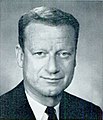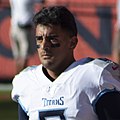University of Oregon
The University of Oregon (UO, U of O or Oregon) is a public research university in Eugene, Oregon. Founded in 1876,[8] the university also has two Portland locations, and manages a marine station, called the Oregon Institute of Marine Biology, in Charleston; and an observatory, called Pine Mountain Observatory, in Central Oregon.
Former names
Oregon State University (1876–1877)[1]
Mens agitat molem (Latin)
"The Mind Moves Mountains" / (lit.) "Mind moves the mass"
October 12, 1872 (established)
October 16, 1876 (opened)
$1.47 billion (2023)[2]
$1.05 billion (2017)[3]
Karl Scholz[4]
23,202[5]
Midsize city[6], 295 acres (1.19 km2)
Green and yellow[7]
- NCAA Division I FBS – Pac-12 (until 2024)
- Big Ten (starting 2024)
- MPSF
- NCATA
The University of Oregon is organized into nine colleges and schools[9] and offers 420 undergraduate and graduate degree programs.[10] Most academic programs follow the 10 week Quarter System.[11] The university is classified among "R1: Doctoral Universities – Very high research activity" and is a member of the Association of American Universities.[12][13] Since July 2014, UO has been governed by its own board of trustees.
UO's 295-acre campus is situated along the Willamette River.[14]
UO student athletes compete as the Ducks and are part of the Pac-12 Conference in the National Collegiate Athletic Association (NCAA). With eighteen varsity teams, the Oregon Ducks are best known for their football team and track and field program.[15][16][17][18] These two teams are even incorporated into the design of the school's "O" logo.[19] In the summer of 2022, UO hosted the 2022 World Athletics Championships. It was the first time the event was held in the United States.[20] UO's colors are green and yellow.[21]
The university has a long and complex relationship with Nike, Inc., and the firm's co-founder Phil Knight.[22][23] As a consequence of state higher-education disinvestment starting in the 1990s, UO has embraced a "University of Nike" image.[23] Fueled by large investments in athletic infrastructure, this trend has accelerated in recent years. Knight, an alumnus, has advocated for both athletic prominence and increased privatisation of the university, and has donated over $1 billion to UO since the late-1980s, much of it going towards athletics.[24][25][26][27][28] The school's "O" logo was designed by Nike in 1998 and sports facility projects on campus typically involve both Knight and Nike.[19][29][22]
$_$_$DEEZ_NUTS#0__titleDEEZ_NUTS$_$_$
$_$_$DEEZ_NUTS#0__subtitleDEEZ_NUTS$_$_$
History[edit]
The land[edit]
The University of Oregon is located on Kalapuya ilihi, the traditional indigenous homeland of the Kalapuya people. Following treaties between 1851 and 1855, Kalapuya people were dispossessed of their indigenous homeland by the United States government and forcibly removed to the Coast Indian Reservation in Western Oregon. Today, Kalapuya descendants are primarily citizens of the Confederated Tribes of Grand Ronde and the Confederated Tribes of Siletz Indians.[30]
Motto[edit]
The university's motto, mens agitat molem translates from Latin as "mind moves mass", or poetically as "minds move mountains." The line comes from the Aeneid by Virgil, Book VI, line 727.[31]
The motto is now shared with the Eindhoven University of Technology, the Military Academy of the German Armed Forces, and the University of Warwick.
$_$_$DEEZ_NUTS#2__titleDEEZ_NUTS$_$_$
$_$_$DEEZ_NUTS#2__descriptionDEEZ_NUTS$_$_$
The multi-branch University of Oregon Libraries serves the campus with library collections, instruction and reference, and a wide variety of educational technology and media services. The UO is Oregon's only member of the Association of Research Libraries. The main branch, the Knight Library, houses humanities and social sciences, Learning Commons, Music Services, Government Publications, Maps and Aerial Photos, Special Collections & University Archives, Media Services, the Center for Educational Technologies, and a Cinema Studies lab to be available in Winter 2010.[162] Other branch locations are:
The UO Libraries hosts Scholars' Bank, an open access (OA) digital repository created to capture, distribute and preserve the intellectual output of the University of Oregon. Scholars' Bank uses open-source DSpace software developed by Massachusetts Institute of Technology and Hewlett-Packard.
The Special Collections & University Archives house a collection of Gardner Fox's literary manuscripts, comic books, and other materials, including over 200 letters from fans.[164] It is also the home to a rare collection of thousands of Japanese senjafuda (votive slips), part of the Gertrude Bass Warner Collection.[165]
The University of Oregon is home to the Jordan Schnitzer Museum of Art and the Museum of Natural and Cultural History.
Academic rankings
100–117
133
98
122
210
401–500
721–730
401–500
253
Organization[edit]
Accreditation[edit]
The university is accredited by the Northwest Commission on Colleges and Universities,[114] which is recognized by the United States Department of Education.
University governance[edit]
The university's internal governance is conducted in accordance with The Constitution of the University of Oregon. The UO Constitution provides a collaborative process that ensures a strong voice for the faculty, acting through the University Senate. The representation of students, civil servants, and administrative employees in the senate ensures this predominantly faculty body operates in the best interests of the entire university community.[115]
UO Board of Trustees assumed control in 2014. The trustees have the broad authority to supervise and manage the university and may exercise all the powers, rights, duties and privileges expressly granted by law or that are implied by law or are incident to the board's powers, rights, duties and privileges.[116]
Former provost Scott Coltrane served as interim president, from August 6, 2014, through June 30, 2015, following the resignation of Michael Gottfredson.[117] This resignation occurred with less than 24 hours notice amidst a number of controversies, including allegations of mishandling of sexual violence,[118] a decline of $100 million in university donations,[119] and the alienation of faculty members around unionization and academic freedom.[120] Including one interim president, Gottfredson was the university's fourth president in six years, a situation that led Chronicle of Higher Education to label the position a "revolving door."[121]
Michael H. Schill was president from 2015 to 2022.[79] John Karl Scholz entered office as the 19th president in 2023.[122][123]
Budget[edit]
UO's FY14 operating revenue total $905 million.[124] As of January 2013, the estimated economic impact of the University of Oregon is $2.6 billion annually.[125] Despite a large increase in undergraduate enrollment, state appropriations are less than what they were 10 years prior. The university also receives less state support than many of its peers. According to FY13-14 data from the AAU, UO ranks last in state funding and receives approximately $47.8 million from the state.[126]
Campus safety and security[edit]
Campus security is enforced by the University of Oregon Police Department.[127]
The University of Oregon appeared in the documentary The Hunting Ground after allowing three basketball players accused of sexual assault to play in an NCAA Tournament. The documentary focuses on campus rape in higher education institutions in the United States.[128]
$_$_$DEEZ_NUTS#7__titleDEEZ_NUTS$_$_$
$_$_$DEEZ_NUTS#7__descriptionDEEZ_NUTS$_$_$
In fiction and popular culture[edit]
Onscreen[edit]
The film National Lampoon's Animal House (1978) was filmed on the university campus and the surrounding area. The building used as the exterior of the Delta House (which belonged to the University of Oregon Pi Kappa Alpha chapter) was demolished in 1986, but the interior scenes were shot in the Sigma Nu house, which still stands. The Omega house belongs to the Phi Kappa Psi fraternity and still stands. The sorority house where Bluto climbs the ladder to peek in on the female students was actually the exterior of the Sigma Nu fraternity.[199] Other buildings used during filming include Johnson Hall, Gerlinger Hall, Fenton Hall, Carson Hall, and the Erb Memorial Union (EMU). The EMU dining facility known as "The Fishbowl" was the site of the famous food-fight scene. The Knight Library and the Jordan Schnitzer Museum of Art can also be seen in the movie.[200]
Other films shot at the university include
$_$_$DEEZ_NUTS#6__titleDEEZ_NUTS$_$_$
$_$_$DEEZ_NUTS#6__subtextDEEZ_NUTS$_$_$
$_$_$DEEZ_NUTS#4__titleDEEZ_NUTS$_$_$
$_$_$DEEZ_NUTS#4__subtextDEEZ_NUTS$_$_$
$_$_$DEEZ_NUTS#5__titleDEEZ_NUTS$_$_$
$_$_$DEEZ_NUTS#5__subtextDEEZ_NUTS$_$_$
$_$_$DEEZ_NUTS#3__titleDEEZ_NUTS$_$_$
$_$_$DEEZ_NUTS#3__subtextDEEZ_NUTS$_$_$
$_$_$DEEZ_NUTS#1__titleDEEZ_NUTS$_$_$
$_$_$DEEZ_NUTS#1__subtextDEEZ_NUTS$_$_$
$_$_$DEEZ_NUTS#1__answer--0DEEZ_NUTS$_$_$
$_$_$DEEZ_NUTS#1__answer--1DEEZ_NUTS$_$_$
$_$_$DEEZ_NUTS#1__answer--2DEEZ_NUTS$_$_$
$_$_$DEEZ_NUTS#1__answer--3DEEZ_NUTS$_$_$
$_$_$DEEZ_NUTS#1__answer--4DEEZ_NUTS$_$_$
$_$_$DEEZ_NUTS#1__answer--5DEEZ_NUTS$_$_$
$_$_$DEEZ_NUTS#1__answer--6DEEZ_NUTS$_$_$
$_$_$DEEZ_NUTS#1__answer--7DEEZ_NUTS$_$_$




















